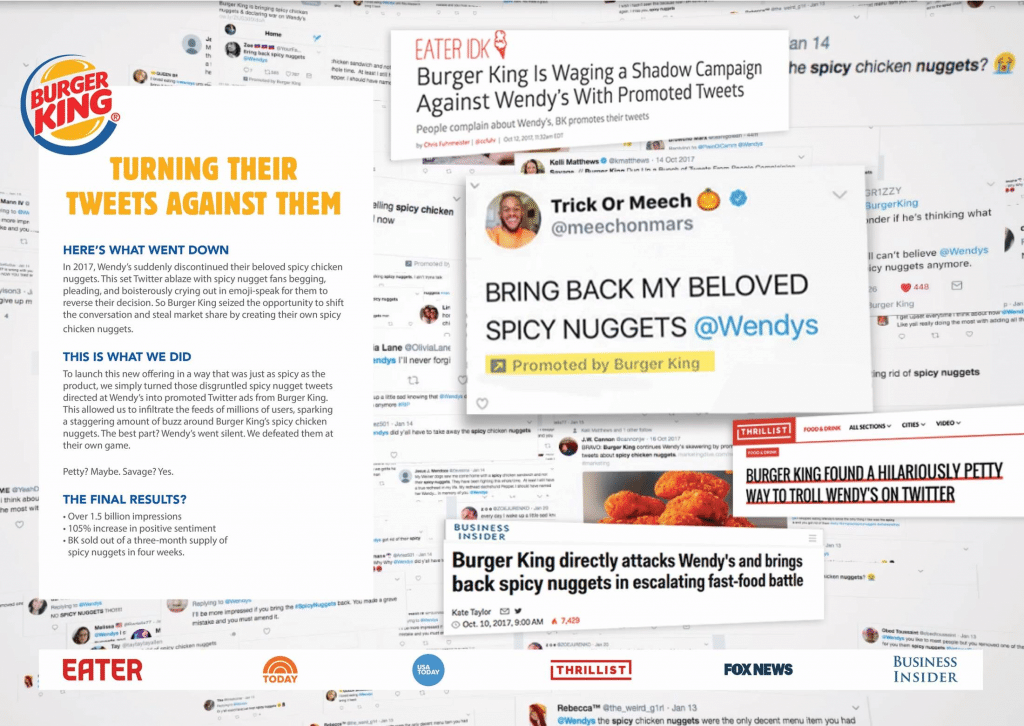When I first started advertising, I was eager to learn about the details that make an ad truly persuasive. I was attracted by the idea of using strategic messaging to influence consumer behavior. However, I rapidly discovered that not all strategies produce equal results. Over the years, via trial and error and numerous hours of research, I’ve accumulated useful insights that I’m thrilled to share with you in my guide to persuasive advertising strategies in 2024.
What is Persuasive Advertising?
Persuasive advertising uses consumers’ desires and interests to persuade them to buy a product or service. This type of advertising frequently concentrates on the benefits the product or service can provide to the end consumer.
Key Takeaways
- Advertising that elicits powerful emotions is more memorable and effective.
- Telling engaging stories helps to humanize your brand and connect with your target audience.
- Testimonials and reviews build trust and influence purchasing decisions.
- Featuring experts and celebrities can increase your brand’s credibility.
- Creating a sense of urgency might motivate consumers to take rapid action.
Understanding Persuasive Advertising
Persuasive advertising seeks to persuade potential customers to prefer your product or service over competitors. This is accomplished through a variety of strategies that draw on human psychology, emotions, and social behavior. According to a Nielsen analysis, successful advertising may enhance brand recognition by 60%, emphasizing the importance of employing the appropriate strategies.
Persuasive advertising strategies fall into three broad categories:
- Ethos: An appeal to ethics, character, and trustworthiness.
- Logos: This appeals to reason and logic.
- Pathos: An appeal to feelings and emotions.
The Science of Persuasion
To create persuasive commercials, it is critical to understand the psychology of customer decision-making. In his groundbreaking book “Influence: The Psychology of Persuasion,” Dr. Robert Cialdini identifies six basic principles of influence: reciprocity, commitment and consistency, social evidence, authority, liking, and scarcity. These concepts are the cornerstone of many great advertising efforts.
Persuasive Advertising Strategies That Work
Let’s look at the persuasive advertising strategies that are effective in 2024, allowing you to design compelling and successful campaigns.

#1. Emotional Appeal
Emotions play an important influence in decision-making. Ads that provoke powerful emotions, such as happiness, sadness, or nostalgia, are more memorable and effective. Coca-Cola, for example, created an emotional connection with consumers with its “Share a Coke” campaign, which personalized bottles with names. According to a study published in Harvard Business Review, emotionally charged content is twice as likely to be shared.
#2. Storytelling
People adore stories. They are an effective technique for engaging audiences and making your brand memorable. Storytelling in advertising helps to humanize your business and create a stronger connection with your target audience. The John Lewis Christmas ads are a perfect illustration of this, as they deliver uplifting stories that engage with viewers and generate a strong emotional connection with the company.
#3. Social Proof
When it comes to making purchasing decisions, consumers frequently consult with others. Social evidence, such as testimonials, reviews, and influencer endorsements, can dramatically improve your brand’s trust. According to BrightLocal research, 88% of buyers trust internet reviews more than personal recommendations, making this an important tactic.
#4. Celebrity testimonial or relationship
A celebrity endorsement or relationship seeks to boost the credibility of your product. It may give your product a more elegant or appealing appearance. Furthermore, this strategy may encourage celebrity admirers to buy the goods to be more like them.
For example, the Proactiv skincare product frequently relies on doctor and celebrity endorsements to demonstrate its effectiveness.
#5. Scarcity
FOMO is a tremendous motivation. Limited-time offers, exclusive discounts, and countdowns can instill a sense of urgency in customers, motivating them to act swiftly. Amazon’s Prime Day is an excellent example, generating large sales through time-limited discounts.
Persuasive Advertising Strategies That Does Not Work
Knowing which strategies to avoid is equally vital as knowing which ones to employ. As I researched persuasive advertising, I discovered that some tactics may capture and convert, while others continuously fail. Let’s look at some strategies that appear promising but have shown to be useless.
#1. Overpromising and underdelivering
Consumers are astute and may quickly detect false claims. Overpromising and failing to deliver can harm your brand’s reputation and undermine trust. Authenticity and transparency are critical to retaining credibility.
#2. Intrusive Advertising
Ads that disrupt the user experience, such as pop-ups or auto-play films with sound, might turn off potential buyers. Instead, concentrate on developing smooth, non-intrusive advertisements that blend naturally into the customer experience.
#3. Ignore Mobile Users
With mobile devices accounting for more than half of global online traffic, skipping mobile optimization can be an expensive error. Ensure that your ads are mobile-friendly to effectively reach and engage a larger audience.
#4. Generic Message
One-size-fits-all messaging is ineffective in today’s individualized marketing landscape. Customize your advertising for specific audience segments to improve relevancy and engagement.
Six Persuasive Advertising Examples
To excel at persuasive advertising, it can be useful to have a variety of examples of what a persuasive ad will look like once published.
Let’s look at some of the most effective and memorable persuasive advertising examples from major brands throughout the world.
#1. Heinz

Heinz, the condiment business, employed persuasive advertising in their collaboration with musician Ed Sheeran to appeal to UK audiences.
Ed Sheeran, a well-known Heinz fan, starred in an advertisement that featured the product in a variety of foods as well as sophisticated and luxurious places.
It contributed to a positive relationship between the performer and the product, making it appear approachable and appealing.
#2. Clorox
Clorox, a cleaning product manufacturer, used persuasive advertising in its “Trusted by Moms” campaign.
The campaign employed wording that emphasized mothers’ faith in cleaners as an emotional hook to connect with consumers.
And by omitting specifics on how many women purchased their items, they were able to connect with mothers as a group.
#3. Lyft

Lyft, a ride-sharing firm, employed persuasive advertising in its adverts, thanking those who were achievers, hard workers, and drivers.
By focusing on the customers who needed the product rather than the ride-share app itself, Lyft was able to establish an emotional bond between people who aspire to achieve their goals and the brand itself.
#4. Apple
Apple, a global technical brand, used reasoning and logic to encourage its audience to buy the latest iPhone.
Rather than comparing the smartphone to competitors, Apple concentrated on what its product had to offer in terms of technological and physical breakthroughs, such as Face ID software and robust glass, two qualities that its target demographic values.
#5. Burger King

Burger King, the fast-food restaurant company, was successful in persuasive advertising with its “Shadow Campaign.”
Creating an online war of sorts on Twitter, the campaign focused on promoting people’s unhappy posts against a competitor, Wendy’s.
Burger King relied on emotions to allow customers to do the talking, which added credibility to their narrative.
Also, this is one of the advertisements that employ persuasive strategies that are entertaining to the audience, resulting in laughter.
#6. HP
HP, a worldwide technology business, targeted a specific audience with its “Nobody’s Watching” campaign.
The persuasive ad campaign focuses on customers’ capacity to effortlessly switch off the camera on their laptops, allowing them to do anything they want without worrying about being seen by others.
By recognizing and tailoring persuasive advertising content to a specific audience’s concern about their product, HP was able to demonstrate that this is not an issue at all.
Essentially, the idea conveyed was that you can be yourself while using your HP laptop.
5 Persuasive Advertising Text Examples
#1. Celebrity Endorsement
Ad Copy: “Drive with confidence like [Celebrity Name].” Experience unrivaled performance and luxury in the all-new [Car Model].
This advertisement promotes ethos by featuring a celebrity endorsement. The celebrity’s achievement, image, and influence lend credibility and trust to the vehicle brand. Consumers who like this celebrity are more inclined to contemplate purchasing the luxury car because they associate it with the celebrity’s characteristics and lifestyle.
Read Also: 10 Most Resounding Influencer Marketing Fails in History (Lessons to Learn)
#2. Emotional Appeal
Ad Copy: “Thousands of animals suffer silently every day.” With your assistance, we can give them a voice. Donate today to [Non-Profit Name] and help us make a difference.”
This non-profit organization’s advertisement uses pathos to elicit pity and compassion for suffering animals. The advertisement establishes an emotional connection with the audience, pushing them to take action and donate to the cause. The persuasive writing example also emphasizes the urgency of the situation, which motivates the viewer to act.
#3. Logical Argument
Ad Copy: “Why Choose [Tech Brand]?” Our cutting-edge processor is 30% faster, our battery life is 20% longer, and our display has 50% more pixels than the leading competitor. The choice is simple.”
This tech company’s persuasive ad uses logos to persuade potential consumers using sensible arguments and proof. By offering precise, comparable facts, the advertisement proves the product’s superiority over competitors, making it a tempting option for buyers looking for the greatest performance.
#4. Limited-Time Offer
Ad Copy: “Don’t Miss Out!” Get 50% off your favorite goods during our Flash Sale, which ends tonight at midnight! Shop today and get your must-haves before they are gone!”
This online store’s persuasive ad uses scarcity to create a sense of urgency and fear of missing out (FOMO). The limited-time offer urges buyers to act quickly and make a purchase before the huge discount expires. This advertisement is powerful because it appeals to the basic human need to avoid missing out on chances.
#5: Social Proof
Ad Copy: “Join the 5 million people who have gotten back in shape with [Fitness App Name].” Try it now and witness results within 30 days!”
The fitness app uses social proof by displaying its enormous user base. The advertisement implies that since millions of individuals have had success with the software, the potential buyer is likely to have similar outcomes. The 30-day commitment establishes a sense of reachable goals and motivates potential customers to test the service.
Tips for Persuasive Writing
Did you find inspiration for your own campaigns? We hope you did.
Here are a few suggestions to consider when writing your ads:
- Choose appropriate persuasive approaches based on your product/service and advertising platform. When producing a print ad or a Google ad campaign, you must create a separate campaign.
- Maintain a balance between persuasive and ethical advertising methods. Maintain transparency, and accuracy, and add actual value.
- Stay up-to-date on current trends, successful campaigns, and changing customer behavior to improve your persuasive advertising strategies. Social media is an excellent source of information.
Conclusion
Mastering persuasive advertising is critical for standing out in a crowded marketplace. Emotional appeal, storytelling, social proof, authority, and scarcity may all be used to create captivating advertising that resonates with your audience and produces results. Remember that authenticity and consistency are essential for building trust and long-term success. Are you prepared to improve your advertising game and achieve outstanding outcomes in 2024?
Related Articles
- 13 EMOTIONAL APPEAL ADVERTISING EXAMPLES THAT YOU CAN COPY
- Brand Advertising: Elevating Your Brand Awareness
- Advertising vs. Marketing: Which Should Your Business Focus On More?
- What is Exactly Cause-Related Marketing? (+ Practical Examples)
- Marketing vs. Advertising: Building a Growth Engine for Your Business






